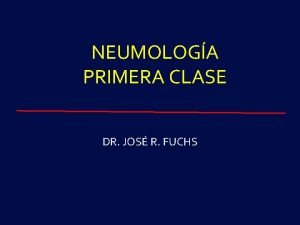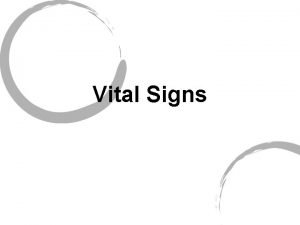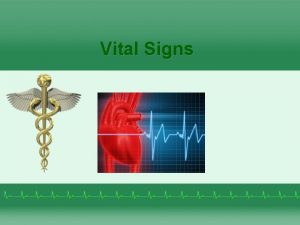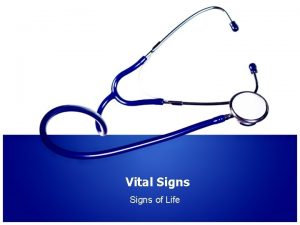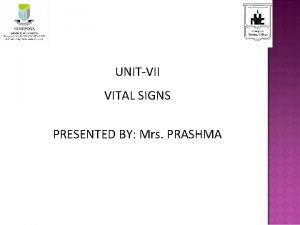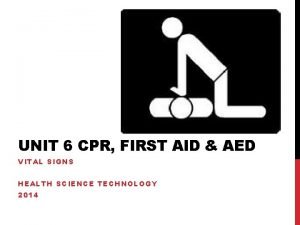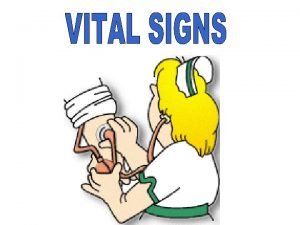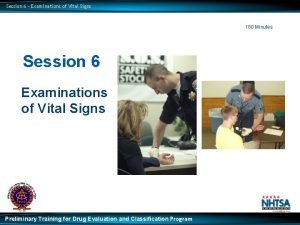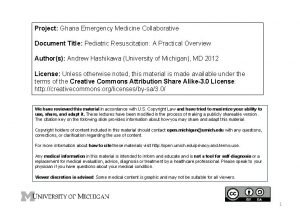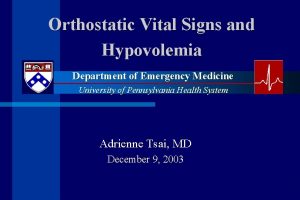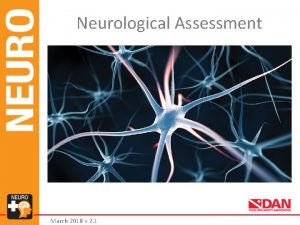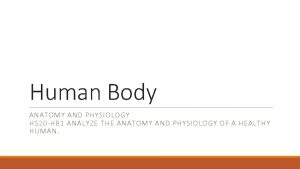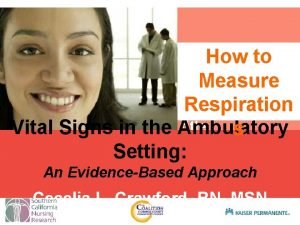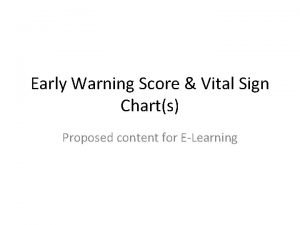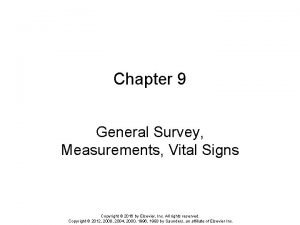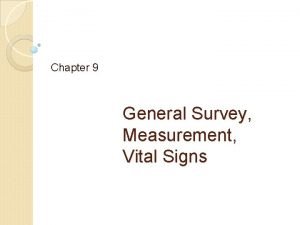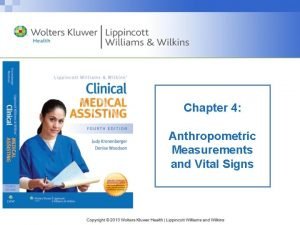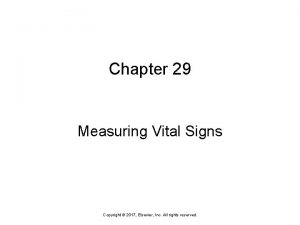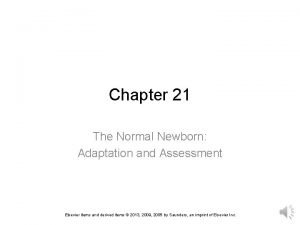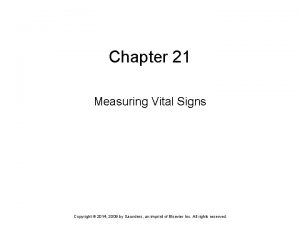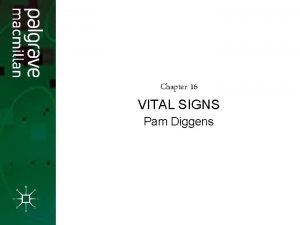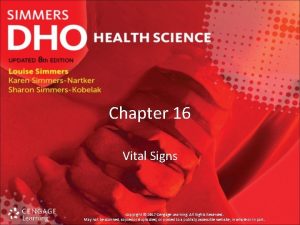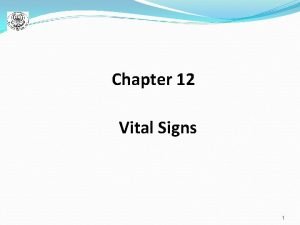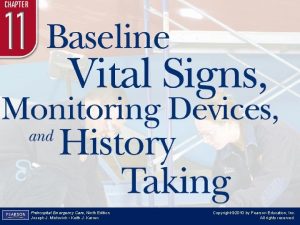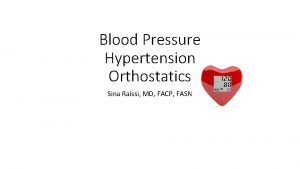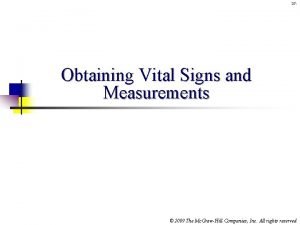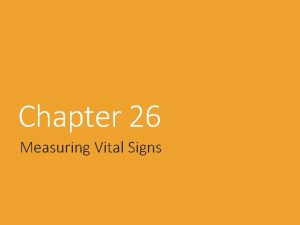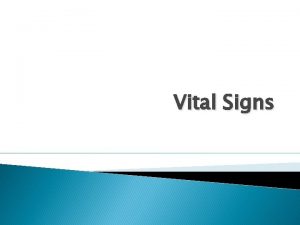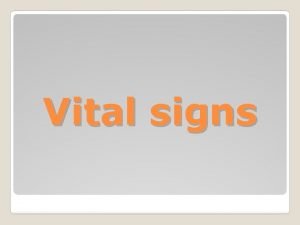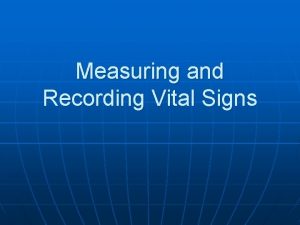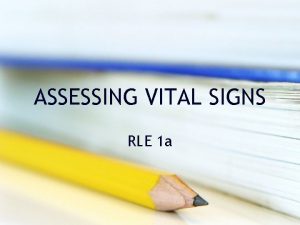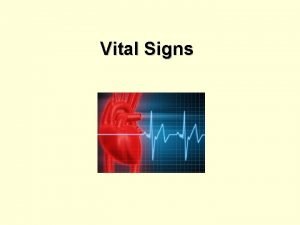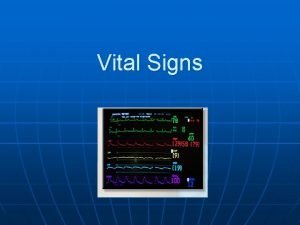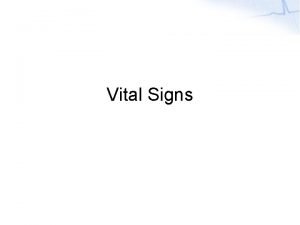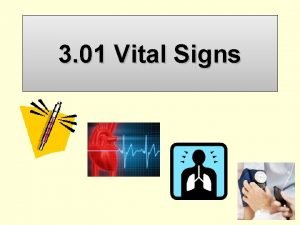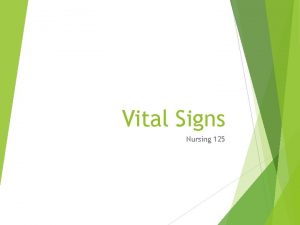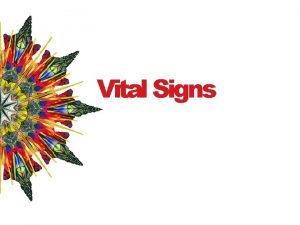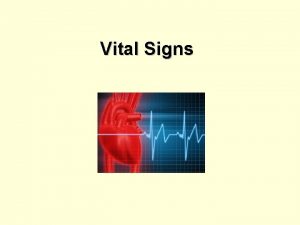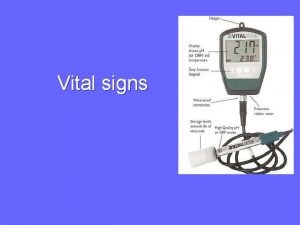Vital Signs signs of life What are vital









































- Slides: 41

Vital Signs “signs of life”

What are vital signs? *Temperature- body temp *Pulse Rate- wave of blood, from contraction of heart. *Respiratory Rate- number of breaths (respirations) per minute. *Blood Pressure- amount of pressure exerted on vessel walls as blood pulsates. 2 pressures measured.

Vital Signs Abbreviations for documenting (charting) “T”- temperature “P”- pulse “R”- respirations “BP”- blood pressure

Temperature Reading Sites: Oral- within mouth, under tongue Axillary- in armpit, aka axilla Tympanic- in ear canal Rectal- through anus, in rectum

Temperature Thermometer types: Electronic- measure temperature through probe at end of device (or) infrared capture. Glass- contains mercury which rises to appropriate level to indicate reading temperature.

Temperature Fahrenheit to Celsius conversion C°= Degrees Celsius Water freezes at 0°C F°= Degrees Fahrenheit Water freezes at 32°F

Temperature °F to °C- Deduct 32, then multiply by 5, then divide by 9 °C to °F- Multiply by 9, then divide by 5, then add 32

Temp-Conversion EX. 96. 8°F-32*5÷ 9= 36°C*9÷ 5+32= 96. 8°F

Temperature Normal adult temperature range considered 98. 6°F Most range from 96. 8°F to 100. 4°F (36. 0°C to 38. 0°C).

Temperature Many factors affect body temperature: Exposure to (heat/cold) Time of day- normally cooler in AM Illness, Stress, Allergic Reaction, etc.

Temperature When temperature is above 100. 4 F (38. 0 C), the patient is febrile- “with fever”. When temperature is within normal range (96. 8 F to 100. 4) the patient is afebrile- “without fever”

Pulse Rate Pulse- wave of blood flow created by contraction of the heart Pulse Rate- number of times the heart beats in one minute (60 seconds). BPM-beats per minute

Pulse Sites Text *Table 9 -1 on page 326

Pulse Sites Temporal-side of head Carotid-neck Apical-just below left nipple (listen) Brachial-inside elbow Radial-wrist Femoral-groin Popliteal- behind knee Pedal-top of foot

Pulse Rhythm- should be regular, “evenly paced”. Can be irregular- “dysrhythmia” If irregular, pulse should always be counted entire minute for average pulse rate. Irregular heart (pulse) rate is sometimes normal condition in infants, through young adulthood.

Pulse- Bilateral? Bilateral- “both sides” pulses should be found “equal bilaterally” If found only on one side of body at a pulse point it is referred to as “unilateral”.

Pulse Volume “Strength of Pulse” Measure of the force against the arterial wall and your fingertips as you palpate. See Chart on next slide Described often as: Absent, Thready/Weak, Strong/Normal, Bounding/Full

Pulse Volume “Chart” 0 Absent, Unable to detect 1 Thready/Weak, difficult to palpate; easy to obliterate 2 Strong/Normal, easily found; obliterated by pressure 3 Bounding/Full, difficult to obliterate with fingertips

Pulse Normal Pulse Ranges: Newborn 120 -160 1 month to 1 year 1 -6 years 80 -140 80 -120 6 to adolescence 75 -110 Adulthood 72 -80 Late Adult 60 -80 Table 9 -2 p. 327

Pulse Rates “outside of normal range” Lower than normal= Bradycardia Higher than normal= Tachycardia

Pulse Rates “Factors that affect pulse rate” Age-slows with age Sex- women tend to have faster rates Level of fitness Physical/mental stress-elevates Lack of Oxygen or low BP-elevates Medications/Alcohol

Respiratory Rate Respiration (ventilation): the act or process of inhaling and exhaling; breathing. Also called ventilation.

Respiratory Rate Like the pulse rate, the normal respiratory rate decreases as a person becomes older. Apnea-absent respirations

Respiratory Rates “Ranges (per minute) by Age” Infant Toddler Preschool 30 -60 24 -40 22 -34 Shool-aged Adolescent/Adult 18 -30 12 -20

Respiratory “Observing chest movement” Adults and Older Children- chest movement outward/upward in. Under 7 years old- use combined chest and abdominal breathing. Abdominal breathing in adults= sign of difficulty breathing (dyspnea)

Respiratory Rate “Assessing” Most common- observe chest movement for one minute Auscultation- with stethoscope on chest wall. Best in infants whose rate is difficult to observe and adults who may be aware you are observing. *warm stethoscope in hands

Respiratory Rate Hyperventilation- increase in respiratory rate; beyond normal range. Causes: Physical/mental stress, fever (pyrexia), lack of oxygen, low blood pressure.

Respiratory Rate Hypoventilation- decrease in respiratory rate; below normal range. Causes: Pain Meds, Alcohol, Hypothermia, severe lack of oxygen, No blood pressure

Respiration Rhythm Respirations should be regular (evenly spaced).

Respiration Quality Volume and effort of each respiration should be comparable throughout the observation. Dyspnea- labored/difficult breathing; accessory muscle use seen in neck, chest, and abdomen

Blood Pressure BP-measurement of the pressure exerted on the arterial walls as blood pulsates. Two pressures are measured. (Systolic and Diastolic) BP is measured in mmhg= millimeters of mercury

Blood Pressure Systolic Blood Pressure (SBP)- pressure exerted on arterial walls during contraction phase of the heart. highest pressure 120/70 - Systolic is 120 mmhg

Blood Pressure Diastolic Blood Pressure- the resting pressure on arteries as heart “relaxes” between contractions. 120/70 - Diastolic is 70 mmhg

Blood Pressure “Normal Ranges” Systolic range= 100 -140 mmhg Diastolic range= 60 -90 mmhg

Blood Pressure Hypotension- When blood pressure drops below the normal range. Hypertension- when blood pressure is higher than the normal range.

Blood Pressure “Hypotension” When a patient is hypotensive (low BP) the body tries different methods to raise the blood pressure. This causes some signs of shock (lack of blood flow to tissues): Change in level of consciousness Increased heart rate/respirations Weak, thready pulses Pale, sweaty skin

Blood Pressure “Hypertension” Hypertension is largely “symptomless” With severe hypertension (180+ systolic/110+ diastolic) a patient may exhibit some of the following: Headache Severe anxiety Shortness of breath Nosebleed

Blood Pressure “most convenient sites” Brachial- upper arm; most common in adults and older children. Radial- lower arm; infants/patients with very large upper arms. Popliteal- thigh; alternative to arms because of disease/trauma/medical treatments to arms/mastectomies Dorsalis Pedis- lower leg; common site for infants when using electronic cuff.

Blood Pressure Sphygmo-man-o-meter Sphygmo= pulse man= pressure meter= measure “measuring pulse pressure”

Blood Pressure “Types of Sphygmomanometers” Mercury-calibrated glass cylinder containing mercury Aneroid- calibrated dial with needle that points to numbers Electronic- digital display, no stethoscope required

Blood Pressure “Palpated BP? ” It is possible to obtain the Systolic (top #) pressure with only a BP cuff. Continuously palpate the radial pulse point, inflate the cuff until the pulse is obliterated and then +10 -20 mmhg. Deflate the cuff slowly, the number on the dial when you first feel the pulse again represents the systolic pressure
 Insidan region jh
Insidan region jh Sign sign everywhere a sign
Sign sign everywhere a sign Capacidad vital y capacidad vital forzada
Capacidad vital y capacidad vital forzada Vital signs definition
Vital signs definition Vital signs normal rate
Vital signs normal rate What are vital signs definition
What are vital signs definition What are the 7 vital signs
What are the 7 vital signs Normal vitals
Normal vitals Temperature
Temperature Sites of pulse rate
Sites of pulse rate Baseline vital signs
Baseline vital signs 8 vital signs
8 vital signs Normal respiratory rate
Normal respiratory rate Conclusion on vital signs
Conclusion on vital signs Hypertension vs hypotension
Hypertension vs hypotension Unit 14:1 measuring and recording vital signs
Unit 14:1 measuring and recording vital signs Oral temperature range
Oral temperature range 6 vital signs
6 vital signs Pediatric vitals
Pediatric vitals Normal pediatric vital signs
Normal pediatric vital signs Pedia vital signs
Pedia vital signs Orthostatic vital signs positive
Orthostatic vital signs positive What is positive orthostatics
What is positive orthostatics Neuro vital signs meaning
Neuro vital signs meaning Normal vital sign ranges
Normal vital sign ranges Respiratory rate for newborn
Respiratory rate for newborn Vital sign chart
Vital sign chart Normal vital signs for all age groups
Normal vital signs for all age groups Orthostatic vitals
Orthostatic vitals Chapter 9 general survey and measurement
Chapter 9 general survey and measurement Anthropometric measurement includes vital signs
Anthropometric measurement includes vital signs Chapter 37 vital signs and measurements true or false
Chapter 37 vital signs and measurements true or false Chapter 29 measuring vital signs
Chapter 29 measuring vital signs Elsevier
Elsevier Measuring vital signs chapter 21
Measuring vital signs chapter 21 Vital signs chart
Vital signs chart Chapter 16.2 measuring and recording temperature
Chapter 16.2 measuring and recording temperature Learning objectives for vital signs
Learning objectives for vital signs Sign chapter 12
Sign chapter 12 Baseline vital signs
Baseline vital signs Mesure de la pression sanguine
Mesure de la pression sanguine Body measurements and vital signs chapter 36
Body measurements and vital signs chapter 36


